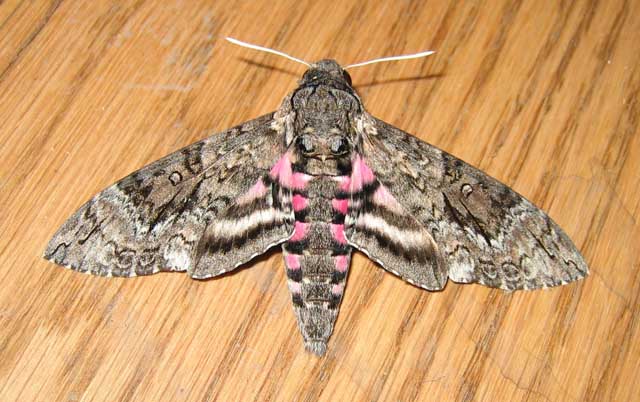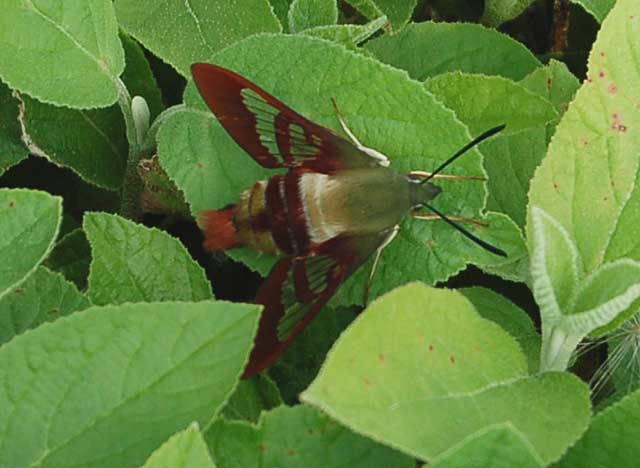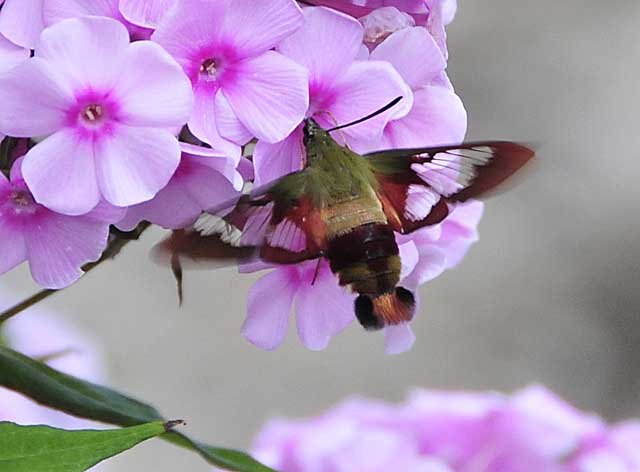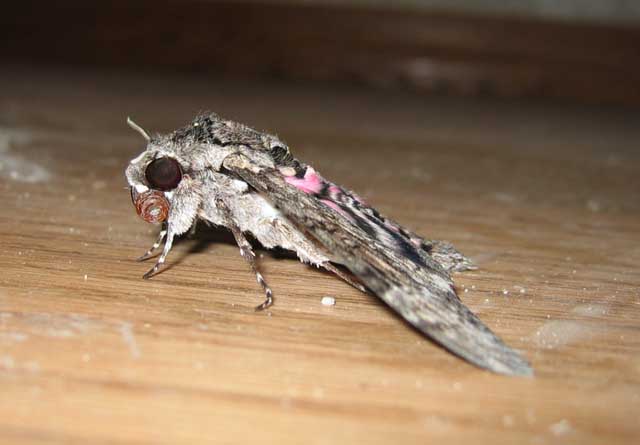Will County, Illinois
Sphingidae

|
|
Updated as per James P. Tuttle's The Hawk Moths of North America, July 28, 2009 |

Will writes, "My family and I just came across the largest moth that we have ever seen - at least live and in person.
"Luckily, I did have my digital camera with me at the time, so I snapped a bunch of photos. After looking at the identification guides, I am positive that it is a Pink-Spotted Hawkmoth.
"We live in Plainfield, Illinois (suburb of Chicago), and I was just wondering if this would be rare for this species of moth to be here?
"This isn't a native - or even close - species, is it? If not, was it probably migrating, or perhaps somehow found its way (as an invasive species type of occurrence)?"
I wrote back: "William,
I am getting sightings of them all over eastern U.S. now from Carolinas, Kentucky, New York, Illinois, etc. Must be a fall migration in full swing after a good growing season further south. Warm weather is probably also playing a part. Thanks for thinking of me."
Will responded: "We actually spotted the moth indoors
in the viewing area of the local horse barn on the wooden floor. It
must have flown in. So it wouldn't get
stepped on, we allowed it to climb on a stick and
moved it outdoors.
"We are in Will County.
"We also have a couple of Wooly Bear caterpillars that
we are trying to take care of over the fall and winter
- my daughter is just fascinated.
"And, we found a caterpillar that I couldn't find in
any Illinois caterpillar listings, which changed into
a cocoon/pupa already after 1 day. I'm not sure if
that will make it though. The closest type I found was
possibly a Sphingidae.
"Thanks for the reply."
Special thanks also to Don Haberkamp who sends this beautiful image of Hemaris thysbe from New Lenox, July 27, 2009.

Hemaris thysbe, New Lenox, Will County, Illinois, July 27, 2009, courtesy of Don Haberkamp.

Hemaris thysbe, Plainfield Township, Will County, Illinois,
July 12, 2010, courtesy of Joseph Paleczny.
Forty-two Sphingidae species are listed in the USGS for Illinois. Not all of the species are reported (eight by USGS as of October 2007) in Will County in northeastern Illinois. I have added some species which I feel may be present (at least occasionally).
It is hoped that this checklist, with the thumbnails and notes, will help you quickly identify the moths you have encountered.
A WO" after the species name indicates that I have no confirmed reports of this species in Cook County, but I (William Oehlke) expect that these moths are present.
Please help me develop this list with improved, documented accuracy by sending sightings (species, date, location), preferably with an image, via email to Bill Oehlke.
Sphinginae subfamily
Smerinthini Tribe:
Macroglossinae subfamilyDilophonotini Tribe:
See Hemaris comparison
to help distinguish the next three species.
|
 | Eumorpha achemon WO, the Achemon Sphinx
This moth is not confirmed for Will County. It is fairly often
reported along the east coast from southern New Jersey
to central Maine. |
 | Eumorpha pandorus WO, the Pandorus SphinxIf you have Grape or Virginia Creeper nearby, then you probably have this species. I often get asked to identify larvae from areas where they have not previously been reported. |
 | Amphion floridensis WO, the Nessus SphinixThis day flier is widely distributed. If you have Virginia Creeper, you probably have the Nessus Sphinx. Two bright, distinct, narrow yellow bands are often visible on the abdomen. |
 | Darapsa choerilus WO, the Azalea SphinxThey are common in New Jersey and common here on Prince Edward Island. You will often see this species listed as Darapsa pholus, especially in older literature. |
 |
Darapsa myron
WO, the Virginia Creeper Sphinx or the
Grapevine Sphinx |
 | Darapsa versicolor WO, the Hydrangea SphinxIf you have hydrangea growing near a stream, then you may have the Hydrangea Sphinx. However, it probably is uncommon. |
 | Deidamia inscriptum WO, the Lettered SphinxThe moth's outer margin of the forewing is deeply scalloped. The upperside is light brown with dark brown markings. There is a small black and white spot near the tip. The upperside of the hindwing is orange-brown with a dark brown outer margin and median line. |
 | Hyles gallii WO, the Bedstraw Hawk Moth or Gallium SphinxThis species is not confirmed in Will County, but I think it might be present. Some years I see them on P.E.I., some years, I do not. |
 | Hyles lineata USGS, the White-lined SphinxAdults usually fly at dusk, during the night, and at dawn, but they also fly during the day over a wide variety of open habitats including deserts, suburbs, and gardens. |
 | Sphecodina abbottii WO, the Abbott's SphinxThis moth is very much under reported on USGS. It is a rapid day flier so is probably not in too many collections. Grape is a popular larval host. |

In the image above there is another indication of injury. The coiled proboscis, or feeding tube, which can be uncoiled/extended to a length of many inches to reach the nectar in deep throated flowers, is not in its usual resting position. Normally the coil is scarcely visible, but remains hidden between tufts of fur/hair on the underside of the thorax.
Possibly this moth was attacked in its evening flight by an owl or bat, and was then dropped to the barn floor.
Enjoy some of nature's wonderments, giant silk moth cocoons. These cocoons are for sale winter and fall. Beautiful Saturniidae moths will emerge the following spring and summer. Read Actias luna rearing article. Additional online help available.
Eggs of many North American species are offered during the spring and summer. Occasionally summer Actias luna and summer Antheraea polyphemus cocoons are available. Shipping to US destinations is done from with in the US.
Use your browser "Back" button to return to the previous page.
This page is brought to you by Bill Oehlke and the WLSS. Pages are on space rented from Bizland. If you would like to become a "Patron of the Sphingidae Site", contact Bill.
Please send sightings/images to Bill. I will do my best to respond to requests for identification help.
 Show appreciation for this site by clicking on flashing butterfly to the left. The link will take you to a page with links to many insect sites. |